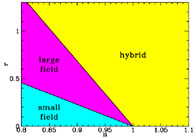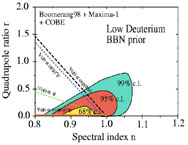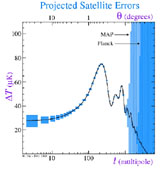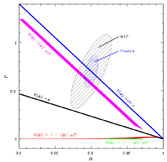


4.8. Inflationary "zoology" and the CMB
We have discussed in some detail the generation of fluctuations in
inflation, in particular
the primordial tensor and scalar power spectra and the relevant
parameters AS, r,
and n. We have also looked at one particular choice of potential
V( ) =
) =

 4
to drive inflation. In fact, pretty much any potential, with
suitable fine-tuning of parameters,
will work to drive inflation in the early universe. We wish to come up
with a classification
scheme for different kinds of scalar field potentials and study how we
might find observational
constraints on one "type" of inflation versus another. Such a "zoology"
of potentials is simple to construct. Figure 14
shows three basic types of potentials:
large field, where the field is displaced by
4
to drive inflation. In fact, pretty much any potential, with
suitable fine-tuning of parameters,
will work to drive inflation in the early universe. We wish to come up
with a classification
scheme for different kinds of scalar field potentials and study how we
might find observational
constraints on one "type" of inflation versus another. Such a "zoology"
of potentials is simple to construct. Figure 14
shows three basic types of potentials:
large field, where the field is displaced by

 ~
mPl from a stable
minimum of a potential, small field, where the field is
evolving away from an unstable
maximum of a potential, and hybrid, where the field is evolving
toward a potential minimum with nonzero vacuum energy.
~
mPl from a stable
minimum of a potential, small field, where the field is
evolving away from an unstable
maximum of a potential, and hybrid, where the field is evolving
toward a potential minimum with nonzero vacuum energy.
 |
Figure 14. A "zoology" of inflation models, grouped into large field, small field, and hybrid potentials. |
Large field models are perhaps the simplest types of potentials. These
include potentials such as a simple massive scalar field,
V( ) =
m2
) =
m2
 2,
or fields with a quartic self-coupling,
V(
2,
or fields with a quartic self-coupling,
V( ) =
) =

 4. A
general set of large field polynomial potentials
can be written in terms of a "height"
4. A
general set of large field polynomial potentials
can be written in terms of a "height"
 and a "width"
µ as:
and a "width"
µ as:
 |
(129) |
where the particular model is specified by choosing the exponent p. In addition, there is another class of large field potentials which is useful, an exponential potential,
 |
(130) |
Small field models are typical of spontaneous symmetry breaking, in which the field is evolving away from an unstable maximum of the potential. In this case, we need not be concerned with the form of the potential far from the maximum, since all the inflation takes place when the field is very close to the top of the hill. As such, a generic potential of this type can be expressed by the first term in a Taylor expansion about the maximum,
 |
(131) |
where the exponent p differs from model to model. In the simplest
case of spontaneous
symmetry breaking with no special symmetries, the leading term will be a
mass term, p = 2, and
V( ) =
) =
 4 -
m2
4 -
m2
 2.
Higher order terms are also possible.
The third class of models we will call "hybrid", named after models
first proposed by Linde
[36].
In these models, the field evolves toward the
minimum of the potential, but the minimum has a nonzero vacuum energy,
V(
2.
Higher order terms are also possible.
The third class of models we will call "hybrid", named after models
first proposed by Linde
[36].
In these models, the field evolves toward the
minimum of the potential, but the minimum has a nonzero vacuum energy,
V( min) =
min) =
 4. In
such cases, inflation continues forever unless an
auxiliary field is added to bring an end to inflation at some point
4. In
such cases, inflation continues forever unless an
auxiliary field is added to bring an end to inflation at some point
 =
=
 c.
Here we will treat the effect of this auxiliary field as an additional
free parameter.
We will consider hybrid models in a similar fashion to large field and
small field models,
c.
Here we will treat the effect of this auxiliary field as an additional
free parameter.
We will consider hybrid models in a similar fashion to large field and
small field models,
 |
(132) |
Note that potentials of all three types are parameterized in terms of a
height  4,
a width µ, and an exponent p, with an additional
parameter
4,
a width µ, and an exponent p, with an additional
parameter
 c
specifying
the end of inflation in hybrid models. This classification of models may
seem somewhat arbitrary. (11)
It is convenient,
however, because the different classes of models cover different regions
of the (r, n)
plane with no overlap (Fig. 15).
c
specifying
the end of inflation in hybrid models. This classification of models may
seem somewhat arbitrary. (11)
It is convenient,
however, because the different classes of models cover different regions
of the (r, n)
plane with no overlap (Fig. 15).
 |
Figure 15. Classes of inflationary potentials plotted on the (r, n) plane. |
How well can we constrain these parameters with observation? Figure 8 shows the current observational constraints on the CMB multipole spectrum. As we saw in Sec. 3, the shape of this spectrum depends on a large number of parameters, among them the shape of the primordial power spectrum. However, uncertainties in other parameters such as the baryon density or the redshift of reionization can confound our measurement of the things we are interested in, namely r and n. Figure 16 shows likelihood contours for r and n based on current CMB data [41].
 |
Figure 16. Error bars in the r, n plane for the Boomerang and MAXIMA data sets [41]. The lines on the plot show the predictions for various potentials. Similar contours for the most current data can be found in Ref. [20]. |
Perhaps the most distinguishing feature of this plot is that the error
bars are smaller than
the plot itself! The favored model is a model with negligible tensor
fluctuations and a
slightly "red" spectrum, n < 1. Future measurements, in
particular the MAP
[39]
and Planck satellites
[40],
will provide much more accurate measurements of the
C spectrum, and will allow correspondingly more
precise determination of cosmological
parameters, including r and n. (In fact, by the time this
article sees print, the first release of MAP data will have happened.)
Figure 17 shows the expected
errors on the C
spectrum, and will allow correspondingly more
precise determination of cosmological
parameters, including r and n. (In fact, by the time this
article sees print, the first release of MAP data will have happened.)
Figure 17 shows the expected
errors on the C spectrum for MAP and Planck, and
Fig. 18
shows the corresponding error bars in the (r, n)
plane. Note especially that Planck will
make it possible to clearly distinguish between different models for
inflation.
spectrum for MAP and Planck, and
Fig. 18
shows the corresponding error bars in the (r, n)
plane. Note especially that Planck will
make it possible to clearly distinguish between different models for
inflation.
 |
Figure 17. Expected errors in the
C |
 |
Figure 18. Error bars in the r,
n plane for MAP and Planck
[38].
These ellipses show the expected 2 -
|
So all of this apparently esoteric theorizing about the extremely early universe is not idle speculation, but real science. Inflation makes a number of specific and observationally testable predictions, most notably the generation of density and gravity-wave fluctuations with a nearly (but not exactly) scale-invariant spectrum, and that these fluctuations are Gaussian and adiabatic. Furthermore, feasible cosmological observations are capable of telling apart different specific models for the inflationary epoch, thus providing us with real information on physics near the expected scale of Grand Unification, far beyond the reach of existing accelerators. In the next section, we will stretch this idea even further. Instead of using cosmology to test the physics of inflation, we will discuss the more speculative idea that we might be able to use inflation itself as a microscope with which to illuminate physics at the very highest energies, where quantum gravity becomes relevant.
11 The classification might also appear ill-defined, but it can be made more rigorous as a set of inequalities between slow roll parameters. Refs. [37 38] contain a more detailed discussion. Back.